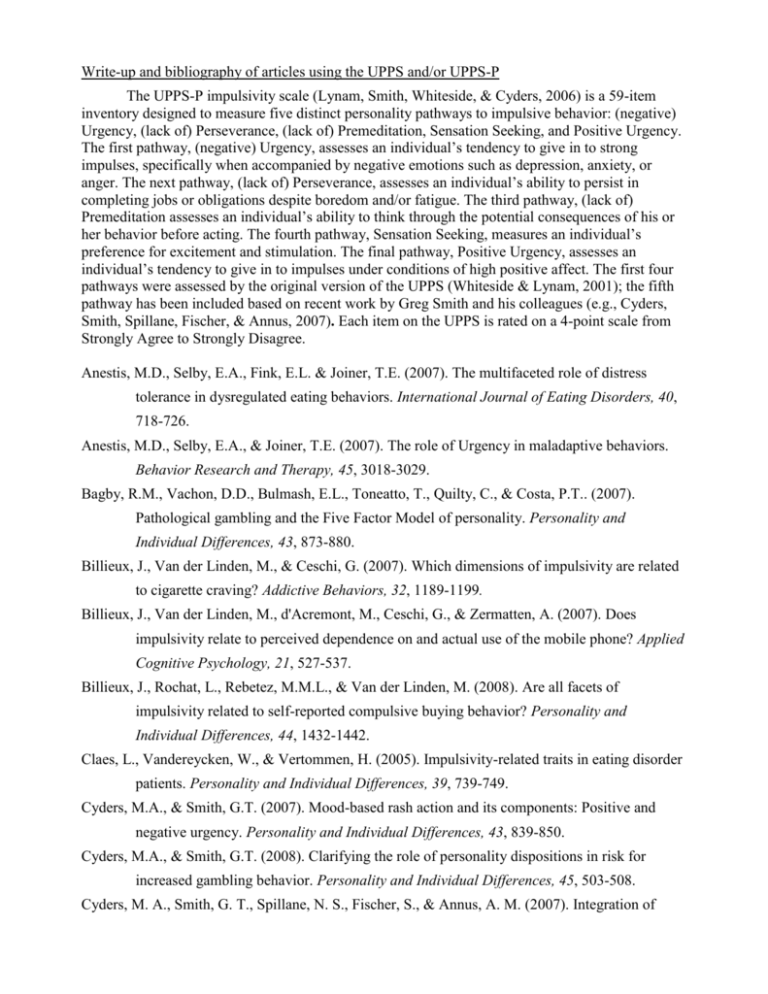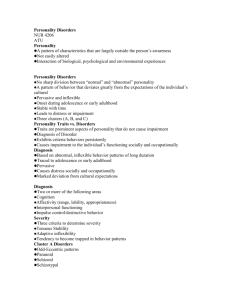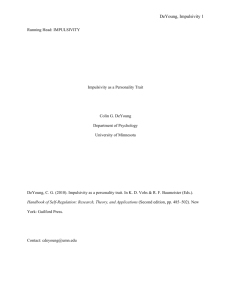Write-up and bibliography of articles using the UPPS and/or UPPS-P
advertisement

Write-up and bibliography of articles using the UPPS and/or UPPS-P The UPPS-P impulsivity scale (Lynam, Smith, Whiteside, & Cyders, 2006) is a 59-item inventory designed to measure five distinct personality pathways to impulsive behavior: (negative) Urgency, (lack of) Perseverance, (lack of) Premeditation, Sensation Seeking, and Positive Urgency. The first pathway, (negative) Urgency, assesses an individual’s tendency to give in to strong impulses, specifically when accompanied by negative emotions such as depression, anxiety, or anger. The next pathway, (lack of) Perseverance, assesses an individual’s ability to persist in completing jobs or obligations despite boredom and/or fatigue. The third pathway, (lack of) Premeditation assesses an individual’s ability to think through the potential consequences of his or her behavior before acting. The fourth pathway, Sensation Seeking, measures an individual’s preference for excitement and stimulation. The final pathway, Positive Urgency, assesses an individual’s tendency to give in to impulses under conditions of high positive affect. The first four pathways were assessed by the original version of the UPPS (Whiteside & Lynam, 2001); the fifth pathway has been included based on recent work by Greg Smith and his colleagues (e.g., Cyders, Smith, Spillane, Fischer, & Annus, 2007). Each item on the UPPS is rated on a 4-point scale from Strongly Agree to Strongly Disagree. Anestis, M.D., Selby, E.A., Fink, E.L. & Joiner, T.E. (2007). The multifaceted role of distress tolerance in dysregulated eating behaviors. International Journal of Eating Disorders, 40, 718-726. Anestis, M.D., Selby, E.A., & Joiner, T.E. (2007). The role of Urgency in maladaptive behaviors. Behavior Research and Therapy, 45, 3018-3029. Bagby, R.M., Vachon, D.D., Bulmash, E.L., Toneatto, T., Quilty, C., & Costa, P.T.. (2007). Pathological gambling and the Five Factor Model of personality. Personality and Individual Differences, 43, 873-880. Billieux, J., Van der Linden, M., & Ceschi, G. (2007). Which dimensions of impulsivity are related to cigarette craving? Addictive Behaviors, 32, 1189-1199. Billieux, J., Van der Linden, M., d'Acremont, M., Ceschi, G., & Zermatten, A. (2007). Does impulsivity relate to perceived dependence on and actual use of the mobile phone? Applied Cognitive Psychology, 21, 527-537. Billieux, J., Rochat, L., Rebetez, M.M.L., & Van der Linden, M. (2008). Are all facets of impulsivity related to self-reported compulsive buying behavior? Personality and Individual Differences, 44, 1432-1442. Claes, L., Vandereycken, W., & Vertommen, H. (2005). Impulsivity-related traits in eating disorder patients. Personality and Individual Differences, 39, 739-749. Cyders, M.A., & Smith, G.T. (2007). Mood-based rash action and its components: Positive and negative urgency. Personality and Individual Differences, 43, 839-850. Cyders, M.A., & Smith, G.T. (2008). Clarifying the role of personality dispositions in risk for increased gambling behavior. Personality and Individual Differences, 45, 503-508. Cyders, M. A., Smith, G. T., Spillane, N. S., Fischer, S., & Annus, A. M. (2007). Integration of impulsivity and positive mood to predict risky behavior: Development and validation of a measure of positive urgency. Psychological Assessment, 19, 107-118. d'Acremont, M. & Van der Linden. (2005). Adolescent impulsivity: Findings from a community sample. Journal of Youth and Adolescence, 34, 427-435. d'Acremont, M. & Van der Linden. (2007). How is impulsivity related to depression in adolescence? Evidence from a French validation of the cognitive emotion regulation questionnaire. Journal of Adolescence, 30, 271-282. d'Acremont, M. & Van der Linden, M. (2007). Memory for angry faces, impulsivity, and problematic behavior in adolescence. Journal of Abnormal Child Psychology, 35, 313-324. Doran, N., Cook, J., McChargue D., Myers M., & Spring, B. (2008). Cue-elicited negative affect in impulsive smokers. Psychology of Addictive Behaviors, 22, 249-256. Fischer S., Anderson K.G., & Smith G.T. (2004). Coping with distress by eating or drinking: Role of trait urgency and expectancies. Psychology of Addictive Behaviors, 18, 269-274. Fischer, S. & Smith, G.T. (2008). Binge eating, problem drinking, and pathological gambling: Linking behavior to shared traits and social learning. Personality and Individual Differences, 44, 789-800. Fischer, S., Smith, G.T., & Anderson, K.G. (2003) Clarifying the role of impulsivity in bulimia nervosa. International Journal of Eating Disorders, 33, 406-411. Fischer, S., Smith, G.T., Annus, A., & Hendricks, M. (2007). The relationship of neuroticism and urgency to negative consequences of alcohol use in women with bulimic symptoms. Personality and Individual Differences, 43, 1199-1209. Fischer, S., Smith, G.T., & Cyders, M.A. (2008). Another look at impulsivity: A meta-analytic review comparing specific dispositions to rash action in their relationship to bulimic symptoms. Clinical Psychology Review, 28, 1413-1425 . Fischer, S., Smith, G.T., Spillane, N.S., & Cyders, M.A. (2005). Urgency: Individual Differences in Reaction to Mood and Implications for Addictive Behaviors. In A. Clark (Ed.), Psychology of moods. Hauppauge, NY: Nova Science Publishers. Gay, P., Rochat, L., Billieux, J., d’Acremont, M., & Van der Linden, M. (2008). Heterogeneous inhibition processes involved in different facets of self-reported impulsivity: Evidence from a community sample. Acta Psychologica, 129, 332-339. Lynam, D.R. & Miller, J.D. (2004). Personality pathways to impulsive behavior and their relations to deviance: Results from three samples. Journal of Quantitative Criminology, 20, 319342. Lynam, D.R., Smith, G.T., Whiteside, S.P., & Cyders, M.A. (2006). The UPPS-P: Assessing five personality pathways to impulsive behavior (Technical Report). West Lafayette: Purdue University. Magid, V. & Colder, C.R. (2007). The UPPS impulsive Behavior scale: Factor structure and associations with college drinking. Personality and Individual Differences, 43, 1927-1937. Miller, J.D., Flory, K., Lynam, D.R., & Leukefeld, C. (2003). A test of the four-factor model of impulsivity-related traits. Personality and Individual Differences, 34, 1403-1418. Mobbs, O., Ghisletta, P., & Van der Linden, M. (2008). Clarifying the role of impulsivity in dietary restraint: A structural equation modeling approach. Personality and Individual Differences, 45, 602-606. Parker, G., Both, L. Olley, A., Hadzi-Pavlovic, D., Irvine, P., & Jacobs, G. (2002). Defining disordered personality functioning. Journal of Personality Disorders, 16, 503-522. Rochat, L., Delbeuck, X., Billieux, J., d'Acremont, M.,Van der Linden, A., & Van der Linden, M. (2008). Assessing impulsivity changes in Alzheimer disease. Alzheimer Disease & Associated disorders, 22, 278-283. Schmidt, R.E., Gay, P., d'Acremont, M., & Van der Linden, M. (2008). A German adaptation of the UPPS Impulsive Behavior Scale: Psychometric properties and factor structure. Swiss Journal of Psychology, 67, 107-112. Schmidt, RE., Gay, P., & Van der Linden, M. (2008). Facets of impulsivity are differentially linked to insomnia: Evidence from an exploratory study. Behavioral Sleep Medicine, 6, 178-192. Schweizer, K. (2002). Does impulsivity influence performance in reasoning? Personality and Individual Differences, 33, 1031-1043. Selby, E.A.; Anestis, M.D., Joiner, T.E. (2008). Understanding the relationship between emotional and behavioral dysregulation: Emotional cascades. Behaviour Research and Therapy, 46, 593-611. Smith, G.T., Fischer, S., Cyders, M.A., Annus, A.M., Spillane, N.S., McCarthy, D.M. (2007). On the validity and utility of discriminating among impulsivity-like traits. Assessment, 14, 155-170. Van der Linden, M., d'Acremont, M., Zermatten, A., Jermann, F., Laroi, F., Willems, S., Juillerat, A., & Bechara, A. (2006). A French adaptation of the UPPS Impulsive Behavior Scale: Confirmatory factor analysis in a sample of undergraduate students. European Journal of Psychological Assessment, 22, 38-42. Verdejo-Garcia, A., Bechara, A., Recknor, E.C., & Perez-Garcia, M. (2007). Negative emotiondriven impulsivity predicts substance dependence problems. Drug and Alcohol Dependence, 91, 213-219. Whiteside, S.P. & Lynam, D.R. (2001). The Five Factor Model and impulsivity: Using a structural model of personality to understand impulsivity. Personality and Individual Differences, 30, 669-689. Whiteside, S.P. & Lynam, D.R. (2003). Understanding the role of impulsivity and externalizing psychopathology in alcohol abuse: Application of the UPPS Impulsive Behavior Scale. Experimental and Clinical Psychopharmacology, 11, 210-217. Whiteside, S., Lynam, D., Miller, J., & Reynolds, S. (2005). Validation of the UPPS impulsive behavior scale: A four-factor model of impulsivity. European Journal of Personality, 19, 559-574. Zermatten, A. & Van der Linden, M. (2008). Impulsivity in non-clinical persons with obsessivecompulsive symptoms. Personality and Individual Differences, 44, 1824-1830. Zermatten, A., Van der Linden, M., d’Acremont, M., Jermann, F., & Bechara, A. (2005). Impulsivity and decision making. Journal of Nervous and Mental Disease, 193, 647-50.










